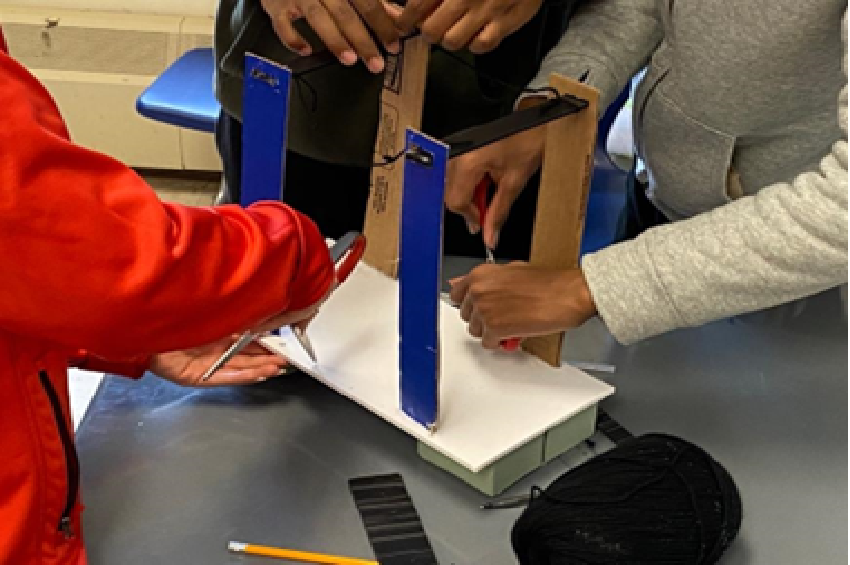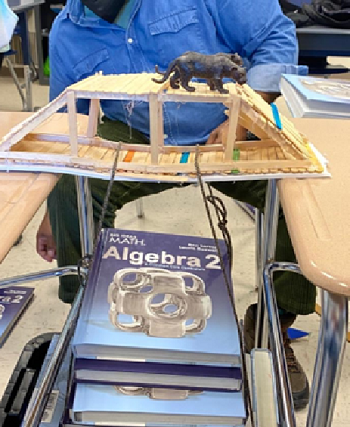Research & Insights / Building Bridges: Teaching mathematics is about so much more than teaching mathematics
Building Bridges: Teaching mathematics is about so much more than teaching mathematics

How do students understand the possibilities available to them in their future? How do students learn to apply mathematics to real-world concepts? How do they learn to develop the teamwork skills necessary for success in school and in their careers? At New Mission High School, mathematics teacher Nigel Charlton engaged students in projects that helped them do all these things and more.
New Mission is one EdVestors’ nine 2021-2022 Math is for Everyone grantees. The Math is for Everyone initiative, which began in 2021, aims to center students, teachers, and school administrators in developing and executing programs and activities intended to improve mathematics and science in Boston Public Schools. Each school’s project is designed by the teachers and administrators within the school, informed by data along with student and teacher feedback.
One of the initiative’s primary goals is Mathematics Culture – Identity and Agency, which Charlton’s Parabolic Bridge Project exemplifies. This past school year, Charlton set out to challenge 10th grade students to build a model bridge, to “provide [students] with additional insight and understanding” into how mathematical concepts play in reality. Students engaged in the necessary actions for this hands-on project, such as strategizing about the design, performing and documenting calculations, procuring materials, assembling their bridges, and testing them. However, a closer look illuminates several aspects of this project that highlight its inherent value to mathematics teaching and learning – including structure, defined roles, cognitive challenge, and mathematical connections.
One critical aspect of mathematics teaching and learning is structure, including the structure of the lessons: how students progress through activities, how and when feedback is provided to students, and how students engage with each other. Charlton’s Parabolic Bridge Project detailed specific expectations for students while leaving room for them to design and build bridges that were visibly and structurally different. Additionally, to facilitate orderly and efficient production of materials, Charlton acted as the “shopkeeper,” cutting materials to size, tracking which materials were used and for what purpose, and maintaining a level of consistency between bridges that supported the subsequent craftsmanship and load testing.

Another aspect of the deliberate structure was that students had defined roles within their teams of three to four. Within each team, there was a captain and a co-captain who acted as a project manager/engineer, a designer who spearheaded the design of the bridge, and a materials person who led the selection and procurement of the best materials for their design. While students had to decide which roles they would take on, each role gave students equitable responsibilities and made each of them a leader on the project, while also creating a need for them to work cooperatively throughout each phase.
With roles defined and woven into the fabric of the project, students were able to approach the challenge presented to them as accomplishable. Added to the planning, design, and build challenge was the need to ensure that the bridge adhered to mathematical principles, constantly performing and documenting calculations. After students had built their bridges, they put them to a load test to see how many of their mathematics textbooks their design could hold before failing, mimicking structural tests done in the real world. For the record, one bridge was able to hold 21 textbooks before collapsing.
Throughout this project, students did not simply design, build, and test a bridge; the project helped them see themselves as managers, engineers, builders, and problem solvers. They connected the mathematics they learned in class to the world around them. In the end, students yearned for more opportunities like this. For those who believed they could complete this project before they started, their academic identities were reinforced. For those who believed they couldn’t, their identities were elevated.



